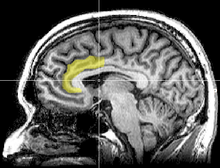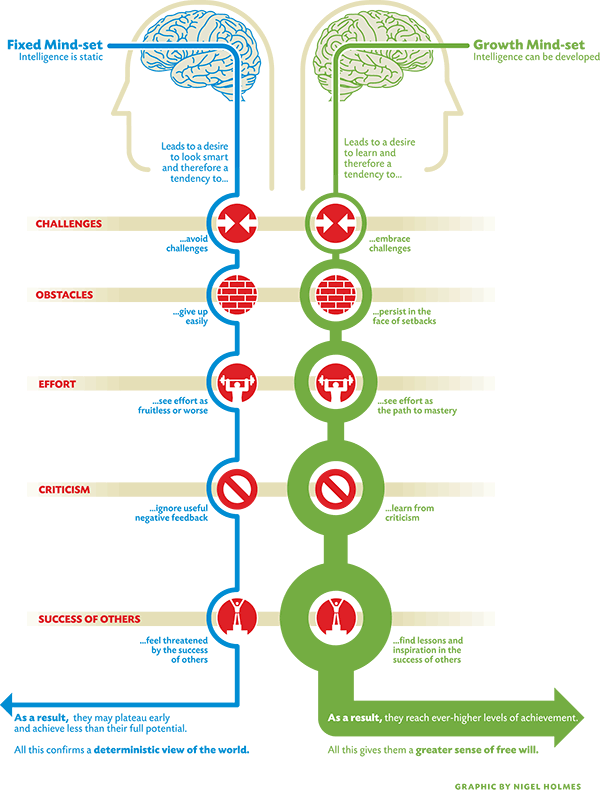Success is going from failure to failure without losing your enthusiasm. Abraham Lincoln
At IQ Mindware we’re now putting more emphasis on the importance of having a growth mindset while doing your brain training and other types of cross-training. This article explores how making mistakes is critical to this growth mindset, and explains what it is.
‘Screw up’ brainwaves
There are two universal reactions to mistakes in the brain, both of which can be detected as distinct electrical waves measured by an electrode cap.
The first – 50 milliseconds after a screw-up, originating in the anterior cingulate cortex that helps monitor performance for errors. This neural reaction is quick and involuntary and can occur below the radar of awareness. This is a signal for the brain that reality is not flowing as it should do.

The anterior cingulate cortex
The second electrical wave (called the Pe signal) arrives later after the cock up – up to half a second into the perceptual event. It occurs over the parietal cortex and signals the subjective experience of actively paying attention to the error and evaluating it, perhaps engaging emotions of regret, guilt, disappointment or anger and imaging what could have been better in the mind’s eye.

The learning brain – Pe brainwave signals
A distinct brainwave profile of these two signals helps us identify good learners. Many studies show the best learning brains have: 1) a bigger initial brainwave response to the mistake and 2) a stronger and more consistent later Pe brainwave.
A question arises: Why do some people have better Pe waves? Why are some people so much more effective at learning from their mistakes?
 Enter Jason Moser at Michigan State University:
Enter Jason Moser at Michigan State University:
Fixed mindsets vs growth mindsets on IQ
Some people have a fixed mindset, believing IQ to be fixed in stone, impervious to change. IQ is like height – fixed in young adulthood. Others have a growth mindset about their mental capacities, believing they can get better at almost anything with enough time and effort.
Mosner found that our mindsets about our brainpower determine how we respond to cock-ups, which in turn determines how well we learn and improve our performance.
One big difference between people who think intelligence is malleable and those who think intelligence is fixed is how they respond to mistakes. Jason S. Moser
Mosner’s mindsets-Pe wave experiment
Moser first gave out a questionnaire to determine which participants in his experiment had a fixed mindset or a growth mindset about intelligence. In the experiment a simple task was used in which performance was monitored. It was boring enough that people would frequently zone out and make mistakes. While performing the task, participants wore EEG caps, monitoring their brain waves.
Results showed that those participants with a growth mindset were significantly better at learning from their mistakes. Those with a growth mindset generated a much larger Pe signal (up to x3 as big), revealing increased attention to their mistakes.
And what’s more, this increased Pe signal was closely linked to improvement in performance on the task after the errors. Because the subjects were thinking about what they got wrong, they learned how to get it right.
It’s how you deal with failure that determines how you achieve success. David Feherty
Failure in the classroom: Lessons for all of us
Stanford psychologist Carol Dweck is known for her research on fixed vs growth mindsets.
Her most famous study was done in twelve different schools involved giving more than 400 fifth graders. Students were given feedback that either induced a fixed or a growth mindset, and Dweck looked at the effect of this on how they tackled a series of tests.

Test Set 1: Creating the mindset
First they were given a test of nonverbal puzzles – not a hard test at first. After the test, the students were told their score, and given a single line of praise. Half of the kids were praised for their intelligence.
“You must be smart at this,” the researcher said. This encouraged a ‘fixed mindset’.
The other students were praised for their effort:
“You must have worked really hard.” This encouraged a ‘growth mindset’.
Test Set 2: Choosing a challenge
The students were then allowed to choose between two follow up tests – the first described as a more difficult set of puzzles, the second an easy test, similar to the one they just took.
Depending on the ‘fixed’ vs ‘growth’ feedback, there was a dramatic difference in the choice of test: nearly 90% of the kids praised for their effort chose the harder test. But most of the kids who were praised for their intelligence chose the easier test.
Why? According to Dweck, praising children for intelligence encourages them to hold onto an image of ‘looking’ smart. Making a mistake could threaten this privileged (fixed) status. Those who were praised for effort were focusing more on the learning process itself, not concerned about protecting a fixed image of themselves as good or bad.
Test Set 3: Grit
Dweck went on to show that fear of failure actually impairs learning. She gave the same fifth graders yet another test. This test was difficult — it was originally written for eighth graders – and Dweck wanted to see how the children would respond to the challenge.
Again another dramatic difference: The kids who had the growth mindset worked hard at figuring out the puzzles. Those with the fixed ‘I’m bright’ mindset were easily discouraged. Mistakes were seen as a sign of failure.
Test Set 4: Learning from others
After test set 3, the two groups of students were then given the option of looking either at the exams of students who did worse or those who did better. Another big difference: Students praised for their intelligence almost always wanted to see the poor performers – to affirm their status as bright. Students praised for hard work were more interested in looking at the higher scoring exams. They wanted to learn from their errors and do better.
Test Set 5: Overall gains in performance
The final round of tests was the same difficulty level as the first test. Students who were praised for their effort – with a growth mindset – exhibited significant improvement, raising their average score by 30 percent. With a growth mindset these students were willing to challenge themselves, even if it meant failing at first, they ended up performing at a much higher level.
By contrast, those who were praised for being smart saw their scores drop by nearly 20 percent. The aversion to failure and error had actually resulted in regression for these children.
Dweck’s Mindset Model
Here’s Dweck’s mindset model:

Take home: succeed through failure
Don’t fear failure and seek to avoid it, but embrace it as one of the best mindhacks for performance gains that’s out there. The better you think you might be, the more you should be doing this to cultivate your ability.
Unless we experience the unpleasant symptoms of being wrong — that surge of Pe activity a few hundred milliseconds after the error, directing our attention to the very thing we’d like to ignore — the brain will never rewire itself to do better. We’ll keep on making the same mistakes, forsaking self-improvement for the sake of our self-image.
I’ve missed more than 9000 shots in my career. I’ve lost almost 300 games. 26 times, I’ve been trusted to take the game winning shot and missed. ..I’ve failed over and over and over again in my life. And that is why I succeed.
Michael Jordan
.